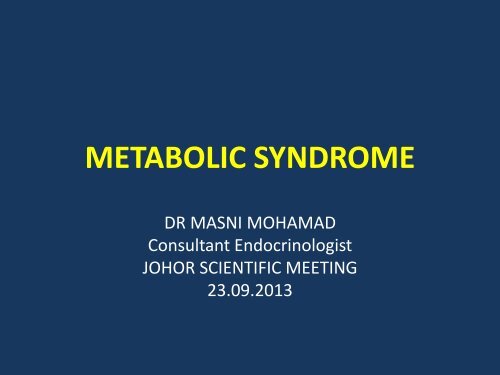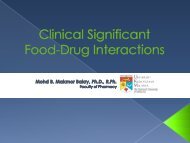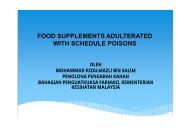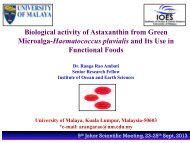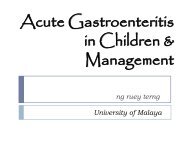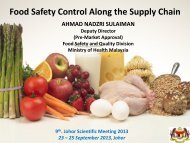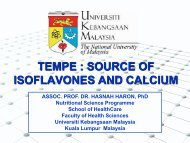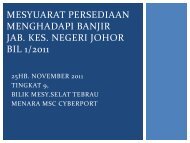G2 (1) Metabolic syndrome
G2 (1) Metabolic syndrome
G2 (1) Metabolic syndrome
You also want an ePaper? Increase the reach of your titles
YUMPU automatically turns print PDFs into web optimized ePapers that Google loves.
OBJECTIVES• Definition and diagnosis• Pathophysiology: Insulin Resistance• Clinical significance and implications• Prevalence: MSSM study and MetS inPenisular Malaysia.• Management of MetS
DefinitionA constellation of metabolic risk factors that consist of• Atherogenic dyslipidemia ( raised TG, apo B, smallLDLparticles plus low HDL cholesterol)• Elevated blood pressure• Elevated glucose associated with insulin resistance• Prothrombotic state• Proinflammatory state• Many of these factors require special testing, and notmeasured in clinical practice
Diagnosis• The National Cholesterol EducationProgramme Adult Treatment Panel III ( NCEPATP III) 2001 report proposed a simple schemefor routine diagnosis of metabolic <strong>syndrome</strong>(MetS)• Diagnose metabolic <strong>syndrome</strong> if a person hasat least 3 of the 5 criteria
Which Criteria to make the Diagnosis• NCEP ATP III• IDF 2005 later Harmonized• WHO
Third Report of the Expert Panel on Detection, Evaluation and Treatment of High Blood Cholesterol in Adults (Adult Treatment PanelIII) JAMA. 2001;285:2486-2497.ATP III:Diagnosing The Cardio-<strong>Metabolic</strong> Syndrome , 2001Risk FactorAbdominal obesity †(Waist circumference ‡ )MenWomenTGHDL-CMenWomenBlood pressureFasting glucoseDefining Level>102 cm (>40 in) >90cm>88 cm (>35 in) >80cm150 mg/dL (≥1.7 mmol/l)40 mg/dL (< 0.95 mmol/l)
International Diabetes Federation (IDF)Consensus Definition 2005The new IDF definition focusses on abdominalobesity rather than insulin resistance
International Diabetes Federation (IDF) ConsensusDefinition 2005Central ObesityWaist circumference– ethnicity specific*– for Europids: Male > 94 cmFemale > 80 cmplus any two of the following 4:Raised triglyceridesReduced HDL cholesterolRaised blood pressureRaised fasting plasmaglucose> 150 mg/dL (1.7 mmol/L)or specific treatment for this lipid abnormality< 40 mg/dL (1.03 mmol/L) in males< 50 mg/dL (1.29 mmol/L) in femalesor specific treatment for this lipid abnormalitySystolic : > 130 mmHg orDiastolic: > 85 mmHg orTreatment of previously diagnosed hypertensionFasting plasma glucose > 100 mg/dL (5.6 mmol/L) orPreviously diagnosed type 2 diabetesIf above 5.6 mmol/L or 100 mg/dL, OGTT is stronglyrecommended but is not necessary to define presence of the<strong>syndrome</strong>.
International Diabetes Federation (IDF)Definition• Modified ATPIII definition– Fasting Glucose > 100mg/dl (5.6 mmol/l)– Adjusted waist circumference based on ethnicity(i.e. Asians with lower waist circumferencethreshold than pacific islanders)
WHO definition of IRS, 1999AT LEAST ONE OF:AT LEAST TWO OF:•Glucose intolerance•IGT•Type 2 DM•Insulin resistance•Hyperuricaemia•Coagulation disorders•Raised PAI-1+• Impaired glucose regulationor diabetes• Insulin Resistance• BP > 140/90• MicroalbuminuriaUAE > 20ug/minA:C ratio > 30 mg/g• TG > 1.7 mmol/l• HDL-C< 0.9 mmol/l in men 0.9 for men‣0.85 for womenBMI > 30 kg/m2=IRSOther components that may be part of the <strong>syndrome</strong> but not necessary for diagnosis
Can we apply NCEP ATP III Definitions ofMS to Asians?• data from 1998 Singapore National Health Survey• cross-sectional survey - 4,723 men and women of Chinese, Malay, andAsian-Indian ethnicity aged 18-69 years.• The prevalence of the MS using the NCEP ATP III criteria with and withoutthe modified waist circumference criteria M 90cm F 80cm.• RESULTS: In Asians, decreasing waist circumference increased the crudeprevalence of the metabolic <strong>syndrome</strong> from 12.2 to 17.9%.• more common in men (prevalence 20.9% in men versus 15.5% in women;P < 0.001• Prevalence 28.8% in Asian-Indians, 24.2% in Malays, and 14.8% in Chinese;P < 0.001• CONCLUSIONS: NCEP ATP III criteria, applied to an Asian population, willunderestimate the population at risk. With a lower WC cutoff, theprevalence of the MS is comparable to that in Western populations.• Ethnic differences are likely to exist between populations across Asia.Tan CE et al Diabetes Care Volume 27(5) May 2004 pp 1182-1186
DEFINITIONS OF METABOLIC SYNDROMERisk Factors [RF] WHO [1999] ATPIII [2001] IDF [2005]Obesity:BMI (kg/m2) orWaist (cm)BMI ≥ 30&/or WHR>0.9 [M], >0.85 [F]WC [Caucasian]:M ≥ 102F ≥ 88WC [Asian]:M ≥ 90F ≥ 80Raised BP (mmHg)Systolic/Diastolic≥140/90or on Rx≥ 130/85or on Rx≥ 130/85or on RxElevated FastingGlucose (mmol/l)DM, IGT or IR ≥6.1 or DM ≥5.6 or DMMicroalbuminuria(UAE or ACR)≥ 20µg/min orACR≥30 mg/gNot usedNot usedRaised TG (mmol/l) ≥1.7 ≥1.7 ≥1.7Reduced HDL-C(mmol/l)
DEFINITIONS OF METABOLIC SYNDROMERisk Factors [RF] WHO [1999] ATP III [2001] IDF [2005] Harmonized[‘09]Obesity:BMI (kg/m2) orWaist (cm)Raised BP (mmHg)Systolic/DiastolicBMI ≥ 30&/or WHR>0.9 [M], >0.85 [F]≥140/90or on RxWC[Caucasian]:M ≥ 102F ≥ 88≥ 130/85or on RxWC [Asian]:M ≥ 90F ≥ 80≥ 130/85or on RxWC [Asian]:M ≥ 90F ≥ 80≥ 130/85or on RxFasting Glucose(mmol/l)DM, IGT or IR ≥6.1 or DM ≥5.6 or DM ≥5.6 or DMMicroalbuminuria(UAE or ACR)≥ 20µg/min orACR≥30 mg/gNot used Not used Not usedRaised TG (mmol/l) ≥1.7 ≥1.7 ≥1.7 ≥1.7Reduced HDL-C(mmol/l)
OBJECTIVES• Definition and diagnosis• Pathophysiology: Insulin Resistance• Clinical significance and implications• Prevalence: MSSM study and MetS inPenisular Malaysia.• Management of MetS
Insulin Resistance:Relation to Visceral ObesityVisceralObesityInsulinResistanceFree fattyacidsType 2 diabetesDyslipidemia(TG, sdLDL, HDL)HypertensionInflammationAltered vascularreactivityImpaired fibrinolysisNASHAtherosclerosis
• Adipocyte derives hormones called adipokinesplay a key role in adipose tissue metabolismand in development of insulin resistance• Beneficial adipokines are,• Leptin• Adiponectin• Harmful adipokines are,• Resistin• TNF-α• IL-6Adipocyte and MetS
OBJECTIVES• Definition and diagnosis• Pathophysiology: Insulin Resistance• Clinical significance and implications• Prevalence: MSSM study and MetS inPenisular Malaysia.• Management of MetS
Clinical importance of MSPresence of MS increases risk of• Atherosclerotic cardiovascular disease(ASCVD) by at least 2- fold- coronary artery disease, CVA, CVS mortality• Type 2 Diabetes by 5-fold. Risk is highest inthose with IGT/IFG.• Costs of these health-care problems are large
Hazard Ratio<strong>Metabolic</strong> Syndromeand Mortality From CVD, CHD43(N=2,431)2100 1 2 3 4 5No. of <strong>Metabolic</strong> Syndrome CriteriaCVD * 1.00 1.71 1.66 2.16 2.01 3.59CHD † 1.00 1.82 1.44 1.88 2.00 3.37P=0.007P=0.046*Adjusted for age, sex, race or ethnicity, education, smoking status,non–HDL-C, recreational/nonrecreational activity, white blood cell count, alcohol use,prevalent heart disease and stroke.†Similar adjustments except for prevalent stroke.Data from Ford ES. Atherosclerosis. 2004;173:309-314.
Impact of the <strong>Metabolic</strong> Syndrome on Mortality FromCHD,CVD, and All Causes in US Adults: NHANES IIProspective Cohort Study with 13 year F/U n=6255 ages 30-75 years5040Deaths/1000 person yearsAdjusted for age and genderNeither MetS nor DM MetS without DM MetS with DMDM Prior CVD Prior CVD and DM44.1Hazard Ratiofor CHDNo MetS RF 1.01-2 MetS RF 2.13028.126.130.9MetS 2.9201002.64.34.86.310.9175.37.88.6CHD Mortality CVD Mortality Total MortalityMalik, S et al. Circulation. 2004;110:1245-125011.516.714.417.121.1MetS+DM 5.0CVD 6.8DM+CVD 11.3<strong>Metabolic</strong> Syndrome more strongly predicted CHD, CVD, andmortality than its individual components.
KUOPIO Heart Study• Finnish adult cohort, no CVD and non DM• Middle age 45 – 65yrs• Prospective, follow up 12 years• <strong>Metabolic</strong> Syndrome had a 2X increased all-causemortality ( mainly CVS mortality)• 10 yr risk of CVS death 10%• Include nonfatal MI, nonfatal CVA 15-20%JAMA 2003, 288: 2709 - 2716
<strong>Metabolic</strong> Syndrome: Total and CV Mortality in Middle-AgedMen in Kuopio Heart StudyCumulativeHazard (%)All-Cause MortalityCardiovascular DiseaseMortality2015<strong>Metabolic</strong> SyndromeYesNo2015<strong>Metabolic</strong> SyndromeYesNo10RR (85% CI)2.13 (1.64-3.61)10RR (85% CI)3.55 (1.96-6.43)55No. at Risk<strong>Metabolic</strong>Syndrome00 2 4 6 8 10 12Follow-up, gYes 866 852 834 292No 288 279 234 100Lokka, H-M, et al JAMA 2002; 288: 2709-271600 2 4 6 8 10 12Follow-up, gYes 866 852 834 292No 288 279 234 100RR indicates relative risk; CI, confidence interval. Median follow-up (range) for survivors was 11.6 (9.1-19.7) years
UPDATES• Recurrent preeclampsia more likely afterpostpregnancy metabolic Syndrome.(<strong>Metabolic</strong> <strong>syndrome</strong> between pregnancies)Harding, A. <strong>Metabolic</strong> Syndrome Sharply Boosts Risk of Recurrent Pre-Eclampsia.Medscape. Mar 21, 2013.
OBJECTIVES• Definition and diagnosis• Pathophysiology: Insulin Resistance• Clinical significance and implications• Prevalence: MSSM study and MetS inPenisular Malaysia.• Management of MetS
<strong>Metabolic</strong> Syndrome Survey inMalaysia (MSSM)• Cross-sectional, total subjects :4341 with mean age 47.8 (14.5)• Peninsular & East Malaysia divided into 5 zones represented by astate (urban & rural areas) :1. East Coast: Kelantan- KB & Salor (USM)2. Central: Selangor- Klang (UM), T Karang (UKM)3. South: Johor- JB, Pontian (Monash)4. West: Penang, Taiping (Penang Medical College)5. East Malaysia: Sabah- K Kinabalu, Lahad Datu (UMS)
HARMONIZING THE METABOLIC SYNDROME. A Joint Interim Statement of theInternational Diabetes Federation Task Force on Epidemiology and Prevention; NationalHeart, Lung, and Blood Institute; American Heart Association; World Heart Federation;International Atherosclerosis Society; and International Association for the Study ofObesity. K.G.M.M. Alberti, et al. Circulation 2009; 120: 1640-1645
DEFINITIONS OF METABOLIC SYNDROMERisk Factors [RF] WHO [1999] ATP III [2001] IDF [2005] Harmonized[‘09]Obesity:BMI (kg/m2) orWaist (cm)Raised BP (mmHg)Systolic/DiastolicBMI ≥ 30&/or WHR>0.9 [M], >0.85 [F]≥140/90or on RxWC[Caucasian]:M ≥ 102F ≥ 88≥ 130/85or on RxWC [Asian]:M ≥ 90F ≥ 80≥ 130/85or on RxWC [Asian]:M ≥ 90F ≥ 80≥ 130/85or on RxFasting Glucose(mmol/l)DM, IGT or IR ≥6.1 or DM ≥5.6 or DM ≥5.6 or DMMicroalbuminuria(UAE or ACR)≥ 20µg/min orACR≥30 mg/gNot used Not used Not usedRaised TG (mmol/l) ≥1.7 ≥1.7 ≥1.7 ≥1.7Reduced HDL-C(mmol/l)
SOCIODEMOGRAPHIC CHARACTERISTICS OF SUBJECTSCHARACTERISTICSURBAN(n = 2,214)RURAL(n = 2,127)TOTAL(n = 4341Male [n (%)] 768 (34.7) 755 (35.5) 1,523 (35.1)Female [n (%)] 1,446 (65.3) 1,372 (64.5) 2,818 (64.9)Mean age (SD) 47.4 (14.4) 48.3 (14.7) 47.8 (14.5)EDUCATION LEVEL [n (%)]No formal education 349 (15.8) 591 (27.8) 940 (21.7)Primary 366 (16.6) 507 (23.8) 873 (20.2)Secondary 1,146 (52.0) 912 (42.9) 2,058 (47.5)College/University 343 (15.6) 117 (5.5) 460 (10.6)ETHNIC [n (%)]Malay (50.4%) 1,035 (46.7) 1,680 (79.0) 2,715 (62.5)Chinese (23.7%) 547 (24.7) 85 (4.0) 632 (14.6)Indian (7.1%) 322 (14.5) 48 (2.3) 370 (8.5)Pribumi (11%) 282 (12.7) 246 (11.6) 526 (12.1)Others (7.1%) 29 (1.3) 67 (3.2) 96 (2.2)
Prevalence (%)50PREVALENCE OF METABOLIC SYNDROME IN MALAYSIABASED ON DIFFERENT DEFINITIONSMale Female All4542.540353032.134.337.140.243.72520151050WHO ATP III IDF HARMONIZEDWNWM et al, Diab Res Clin Prac 2011
Prevalence (%)PREVALENCE OF METABOLIC SYNDROME BY ETHNIC GROUPS80706051.95043.942.14031.43020100MALAY CHINESE INDIANS OTHERSWNWM et al, Diab Res Clin Prac 2011
Prevalence (%)PREVALENCE OF METABOLIC SYNDROME RISK FACTORSBY ETHNIC GROUPSWC BP HDL-C TG FPG HOMA-IR >2.6807060.868.865.6605052.247.445.2403020100MALAY CHINESE INDIANS OTHERSWNWM et al, Diab Res Clin Prac 2011
Prevalence (%)PREVALENCE OF METABOLIC SYNDROME RISK FACTORSBY AGE GROUPSWC BP HDL-C TG FPG HOMA-IR >2.68080.0706060.451.065.764.452.850403020100 60 YEARSWNWM et al, Diab Res Clin Prac 2011
Prevalence (%)PREVALENCE OF METABOLIC SYNDROME RISK FACTORS BY LOCATIONSWC BP HDL-C TG FPG HOMA-IR >2.6807060504056.650.048.140.634.951.358.454.638.63020100URBANRURALWNWM et al, Diab Res Clin Prac 2011
MetS - where is Malaysiacompared to the rest of theworld?
Prevalence (%)PREVALENCE OF METABOLIC SYNDROME IN OTHER POPULATIONSWHO ATP III IDF403532.134.337.134.03025.82523.020151018.311.69.613.715.150Malaysia USA India H Kong China2008 Ervin, NHANES 2009 Deepa et al, 2006 Ko et al, 2005 Gu et al, 20056.1
Prevalence of MetS in other populations
Prevalence of Pre-obese and Obese (based on CP<strong>G2</strong>004) (1996-2011)
Status of Diabetes Mellitus inMalaysia in the past 25 years1986NHMS I1996NHMS II2006 2006NHMS III NHMS III2006NHMS2011NHMSIII35 yearsold &above30 yearsold &above18 yearsold &above18 – 29yearsold30 yearsold &above30 yearsold &abovePrevalence 6.3% 8.3% 11.6% 2.4% 14.9% 20.8%Known diabetes 4.5% 6.5% 7.0% 0.4% 9.5% 10.7%Newly diagnosed 1.8% 1.8% 4.5% 2.0% 5.4% 10.1%ImpairedGlucoseTolerance (IGT) /Fasting Glucose(IFG)4.8% * 4.3% * 4.2%** 3.1% # 4.7% # 5.3%**based on IGT;# based on IFG
MSSM SUMMARY• High prevalence of MetS risk factors amongMalaysian adults;• By age 40 years old:–60% with abdominal obesity,– 47% with hypertension,–34% with dyslipidemia–20% with diabetes, Pre Diabetes 21.7 %• high risk of developing:– CVD– Diabetes and its complications
OBJECTIVES• Definition and diagnosis• Pathophysiology: Insulin Resistance• Clinical significance and implications• Prevalence: MSSM study and MetS inPenisular Malaysia.• Management of MetS
Management of MS• Current knowledge suggest that each component ofMS should be treated obesity, dysglycemia,dyslipidemia, hypertension• No “magic bullet” – no evidence that treatment of IRper se eliminates the MS• Any treatment should not deal just with MS butshould prevent outcomes of MSPrevention of Type2 DiabetesPrevention of CVD
Cardiovascular Risk Reducing Treatment for Persons With the<strong>Metabolic</strong> Syndrome (MetS) –Risk FactorOverweight/obesityRecommendedTreatmentModerate 500 –1000 cal/ dayreduction per ATPIII dietrecommendationTreatment initiationand/or Goal levelsWC > 88cm (F) >102cm (M) constituteshigher risk levels(Asian cutoff pts 80cm(F) and 90cm (M)Reduction Wt by 7-10% over 6-12 monthsas neededPhysicalinactivity30min/day ofmoderate intensityphysical acitvityIncreasing amount (egto 1h/day) mayprovide additionalbenefits
How Much to Exercise?Mild or Moderate Activity for 30 minutes:Fast walking onflat surfaceCycling onlevel surfaceGardeningSwimmingFishingHousepaintingCleaningwindowsBadmintonBallroomdancingGolfMopping thefloorVolleyballManagement
LIFE STYLE MODIFICATIONS WORKS• Pre-diabetes is a serious medical condition!• It CAN be treated• TRIALS: Da Qing 1997, Finnish study 2001, DPP 2002:persons with pre-diabetes can prevent thedevelopment of T2DM by sustained lifestyle changes• 5-10% reduction in body weight coupled with 30minutes a day of moderate physical activity• Reversal of pre-diabetes and return of blood glucoselevels to the normal range is possible
DPP: Intensive Lifestyle Changes Reduce theRisk of Developing Type 2 Diabetes• 27 centers nationwide (1998-2002)• Pre-diabetes, av. age 51, BMI 34, 68% women, 45% minorityparticipants• Other groups at high risk: >60, women with h/o GDM, firstdegreerelative with diabetes• > 7% loss of body weight and maintenance of weight loss• Dietary fat goal -- 150 minutes per week of physical activityParameter Placebo Metformin850 mg bidLifestyle: diet, exercise,behavior modificationWeight Loss none 5 lbs 1 st yr: 15 lbs, end 10 lbsDiabetes at 2.8 yrs 11% 7.8% 4.8%
MET-hours/weekHbA1c (%): placebo: MTF: Intensive LifestyleWeight Change (kg)FPG (mg/dl)Diabetes Prevention ProgramNew Engl J Med Feb 2002801156-21104200 1 2 3 4Years from Randomization-4-6-80 1 2 3 4Years from Randomization1051000 1 2 3 4Years from Randomization6.16.05.95.80 1 2 3 4Years from Randomization
A Decade Later….DPPOSThe Lancet, Oct 2009• At end of DPP: participants were offered a 16-session program ofintensive lifestyle changes (88% agreed)Parameter Placebo Metformin850 mg bidWeight Loss 60
LIPIDSRisk FactorsLDL-cholesterolRecommendedTreatmentStatins alone or incombination withnicotinic acid or acholesterol absorptioninhibitorTreatment initiationand/or Goal levels< 3.4mmol/L formost MetS pts< 2.6mmol/L(optional goal)< 2.6mmol/L for highrisk/DM< 1.8mmol/L –CVD/DMHDL-cholesterolTriglycerideFibrate or nicotinicacidFibrate or nicotinicacid or statin thateffectively lower TGMinimal goal: >1.0mmol/L in men, >1.3mmol/L (W)Optimal > 1.5mmol/LMinimal goal
Cardiovascular Risk Reducing Treatment for PersonsWith the <strong>Metabolic</strong> Syndrome (MetS)- BLOOD PRESSURERiskFactorRecommendedTreatmentTreatment Initiationand/or Goal levelsElevatedBloodPressureTherapy dependent onpresence of otherconditions asrecommended by JNC 7,high dose diuretic andbetablocker maynegatively impact insulinresistance or dyslipidemiaMinimal goal
Cardiovascular Risk Reducing Treatment for PersonsWith the <strong>Metabolic</strong> Syndrome (MetS)- INSULIN RESISTANCE/ HYPERGLYCAEMIARisk FactorRecommendedTreatmentTreatmentinitiation and/orgoal levelInsulinresistance/Hyperglycaemia•Lifestyle modifications forall persons with MetS•Insulin, metformin, TZDsand other hypoglycaemicmedications for DM• No hypoglycemic therapyfor MetS without DM< 7.0% HbA1c forthose with diabetes< 5.6mmol/L(100mg/dL) forthose with MetS(without DM)
Management of MetS in nutshellTLC-Therapeutic life style,DASH-Dietary approaches to stop hypertension,ETOH-Ethanol
CONCLUSIONS• Definition and diagnosis• Pathophysiology: Insulin Resistance• Clinical significance and implications• Prevalence: MSSM study and MetS inPenisular Malaysia.• Management of MetS
XEat toLive!Live to Eat!Thanks for your attention.


